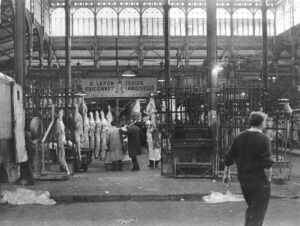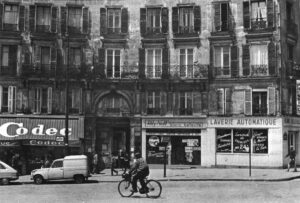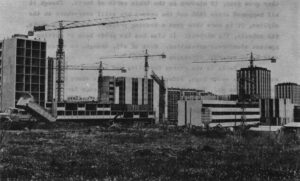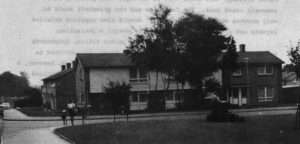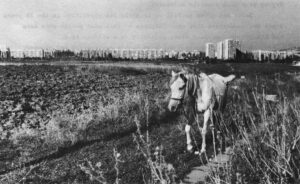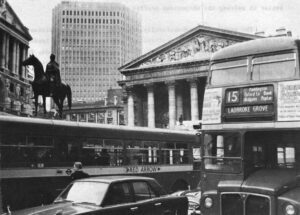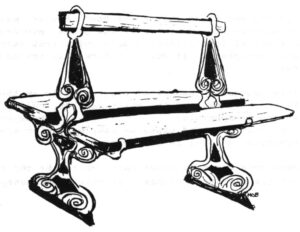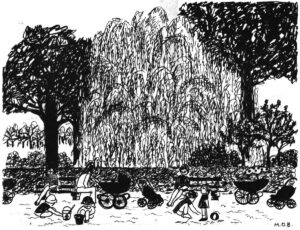Paris, Dec. 28, 1969
Each time I had the chance in Sofia I tried to find out where and from whom the city professionals, especially planners, were learning what to do and how to do it. Sofia seemed (and seems) a city happening late – in some respects facing now the problems of London in the 19th century, Moscow several decades ago.
With Sofia’s planners, theoretically, in a position to shape developments that were private business in London, perhaps less clearly understood when they appeared in Moscow than they are now, Sofia seemed possibly the place of places where repetition of the mistakes of others could be avoided.
Such comparisons are far too facile, and have as much wrong about them as right. The question “How are you avoiding other cities’ mistakes?” remains a useful one, nevertheless.
Kourdalanov, the engineer from the department of progress at the Construction Ministry, at least seemed to understand the question. (He was the man who had spoken of Le Corbusier and parking problems, both pretty foreign to Sofia, and who didn’t seem concerned at being seen talking to me.)
His answer, however, was not encouraging to anyone looking to authoritarian central planning and economic control as the solution to city ills and inefficiencies.
Freely summarized, Kourdalanov said this:
“We have specialists whose job it is to know everything about what goes on in other cities, and of course we never make mistakes because Sofia development is guided by the two-stage master plan which of course provides the right answers, and we couldn’t have problems such as traffic congestion as you do in western cities, anyway.”
I didn’t want to get into a fight with Kourdalanov, who at least was willing to talk openly about some things to me. I asked to meet some of these super planners, but my contacts with officials were being rationed like truffles.
And the point was somewhat peripheral to understanding a place as massively foreign as Sofia, so I let it drop.
Several weeks later a friend in the American embassy sent me a translation of an article in “Zemedelsko Zname” by a “Professor-Architect Asen Stoichov.” Some of its many headlines read:
“THE IMAGE OF TWO EPOCHS IN THE FOUNDATION OF THE TOWN PLANNING CONCEPTION!”
“A Talk on the Problems of the General Plan of the Capital”
“WHERE AND IN WHAT WAY IS THE CENTER TO BE SHAPED UP?”
The article began (and I have shaped up the translator’s English somewhat):
“The Sofia master plan, worked out and approved a decade ago, plainly cannot meet present demands, let alone those of the future….
“In mid-1965 a small collective led by the author was charged with developing a general communications-transport plan for Sofia…The task was completely new to us, we were lacking experience, we had no qualified specialists. Regardless, with the help of experts from neighboring countries and by a brief but effective specialization of the collective’s members, the work was brought to a successful conclusion….”
The old master plan was the framework for his transport plan, Stoichov explains. Since it is “plainly” unable to meet the need, there will have to be minor adjustments in the plans for highways and subway into the center of the city.
“At the beginning of the current Tear,” Stoichov continues, “the master plan of Sofia was placed on completely new, contemporary, scientifically sound foundations. An Administration was founded at the Institute for Projecting and Planning SOFPROECT, which completely took over the town planning of the Capital in all its varieties….
The specifics of Prof. Stoichov’s lengthy proposals are probably not of interest. In summary, he found that since the city, instead of remaining round, will now be elongated, the subway and roads should be elongated too.
And that is very close to all he has to propose.
There is some quite sharp criticism of development that took place following the old master plan that has made a proper urban development impossible.
But there is no challenge to the presumption that Sofia will always be a nucleus surrounded by a gradually thinning cytoplasm, and yet this pattern is breaking down in all the biggest and richest cities of the world. He could reasonably be expected to know that the automobile is moving people and offices and factories out of central cities at least as well as the subway once moved them in, but there is no mention.
The Bulgarians plan to build both roads and cars, or say they do anyway, and yet make no particular plans for parking or keeping pedestrians and cars separate. Cars are not now allowed to park in Sofia streets, they use the sidewalks. This is fine for a city without cars, but it could become a problem.
It is easy to tax a writer for having failed to mention this or that example. Likely, it isn’t particularly useful. But the whole tone of Bulgarian city planning assumes a straight path forward. Branchings and turnings are not contemplated.
I cannot help wondering:
If last decade’s experts are now understood to have been short sighted, and this decade’s planners blithely concede they didn’t know what they were doing when they started, how much are we to believe in the current “scientifically sound foundations?”
Sofia’s planning is not to be dismissed. The city is neat and clean and orderly. Planning control makes a difference. But in Sofia it does not seem to be offering a way to skip a whole generation of city problems by learning from the mistakes of others.
Received in New York on January 5, 1970.
©1970 Andrew Earl Barnes
Andrew Earl Barnes, Assistant City Editor of The Washington Post, is on leave for a year to study European cities as an Alicia Patterson Fund Fellow.

